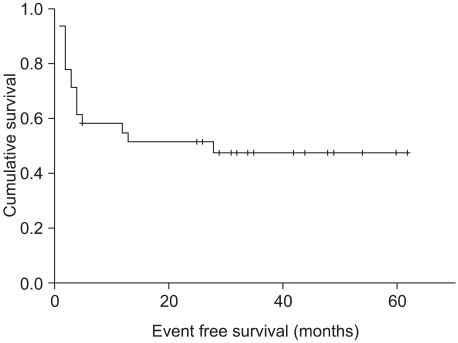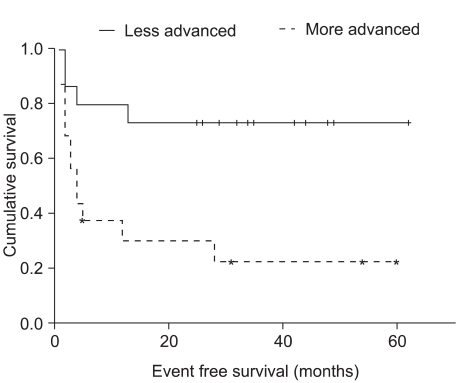Cancer Res Treat.
2007 Jun;39(2):54-60.
Autologous Stem Cell Transplantation using a Modified TAM Conditioning Regimen for Clinically Aggressive Non-Hodgkin's Lymphoma
- Affiliations
-
- 1Division of Medical Oncology, Department of Internal Medicine, College of Medicine, The Catholic University of Korea, Seoul, Korea. ssuki76@catholic.ac.kr
- 2Division of Hematology, Department of Internal Medicine, Catholic Hematopoietic Stem Cell Transplantation Center, The Catholic University of Korea, Seoul, Korea.
Abstract
-
PURPOSE: High-dose chemotherapy (HDT) and autologous stem cell transplantation (ASCT) have been used for the treatment of clinically aggressive non-Hodgkin's lymphoma (NHL). However, the superiority of specific conditioning regimens has not yet been established. The present study evaluated the efficacy and toxicity of a conditioning regimen involving fractionated total body irradiation (TBI), and the use of Ara-C and melphalan (TAM) for clinically aggressive NHL.
MATERIALS AND METHODS
Between March 2002 and December 2004, 31 patients with aggressive NHL received fractionated TBI with a dose of 12 Gy over 3 days, and were administered 9 g/m2 Ara-C and 100 mg/m2 melphalan followed by autologous peripheral blood stem Cell Transplantation at the Catholic Hematopoietic Stem cell transplantation Center Korea. Patients that responded to first line chemotherapy and achieved complete remission (CR), or were in a first sensitive relapse were defined as having less advanced disease, while the other patients were defined as having more advanced disease.
RESULTS
Objective responses were obtained in 24 of 31 patients (77.4%), comprising complete remission in 19 patients (61.3%) and partial remission in 5 (16.1%) patients. The median follow-up time was 28 months (range 1~62 months). At 3 years, the overall survival and event-free survival (EFS) rates were 62.3% and 47.3%, respectively. Patients with less advanced disease and more advanced disease showed 3-year EFS rates of 73.3% and 22.5 %, respectively (p=0.006). Early (within the first 100 days) treatment-related mortality occurred in 3 (9.7%) patients. Of the 31 total patients, 15 (48.4%) developed grade 3 mucositis, 22 (70.9%) developed neutropenic fever, and two (6.5%) developed interstitial pneumonia syndrome >grade 3.
CONCLUSION
The modified TAM conditioning regimen and ASCT appear to be a feasible treatment regimen for clinically aggressive NHL, particularly for patients with less advanced disease.
Keyword
MeSH Terms
-
Cytarabine
Disease-Free Survival
Drug Therapy
Fever
Follow-Up Studies
Hematopoietic Stem Cell Transplantation
Humans
Korea
Lung Diseases, Interstitial
Lymphoma, Non-Hodgkin*
Melphalan
Mortality
Mucositis
Peripheral Blood Stem Cell Transplantation
Recurrence
Stem Cell Transplantation*
Stem Cells*
Whole-Body Irradiation
Cytarabine
Melphalan
Figure
Reference
-
1. Armitage JO. Treatment of non-Hodgkin's lymphoma. N Engl J Med. 1993; 328:1023–1030. PMID: 8450856.
Article2. Philip T, Guglielmi C, Hagenbeek A, Somers R, Van der Lelie H, Bron D, et al. Autologous bone marrow transplantation as compared with salvage chemotherapy in relapses of chemotherapy-sensitive non-Hodgkin's lymphoma. N Engl J Med. 1995; 333:1540–1545. PMID: 7477169.
Article3. Vose JM, Zhang MJ, Rowlings PA, Lazarus HM, Bolwell BJ, Freytes CO, et al. Autologous transplantation for diffuse aggressive non-Hodgkin's lymphoma in patients never achieving remission: a report from the Autologous Blood and Marrow Transplant Registry. J Clin Oncol. 2001; 19:406–413. PMID: 11208832.
Article4. Haioun C, Lepage E, Gisselbrecht C, Salles G, Coiffier B, Brice P, et al. Survival benefit of high-dose therapy in poor-risk aggressive non-Hodgkin's lymphoma: final analysis of the prospective LNH87-2 protocol--a groupe d'Etude des lymph omes de l'Adulte study. J Clin Oncol. 2000; 18:3025–3030. PMID: 10944137.5. Salar A, Sierra J, Gandarillas M, Caballero MD, Marin J, Lahuerta JJ, et al. Autologous stem cell transplantation for clinically aggressive non-Hodgkin's lymphoma: the role of preparative regimens. Bone Marrow Transplant. 2001; 27:405–412. PMID: 11313670.
Article6. Gutierrez-Delgado F, Maloney DG, Press OW, Golden J, Holmberg LA, Maziarz RT, et al. Autologous stem cell transplantation for non-Hodgkin's lymphoma: comparison of radiation-based and chemotherapy-only preparative regimens. Bone Marrow Transplant. 2001; 28:455–461. PMID: 11593318.
Article7. Appelbaum FR, Sullivan KM, Buckner CD, Clift RA, Deeg HJ, Fefer A, et al. Treatment of malignant lymphoma in 100 patients with chemotherapy, total body irradiation, and marrow transplantation. J Clin Oncol. 1987; 5:1340–1347. PMID: 3305793.
Article8. Stein RS, Greer JP, Goodman S, Brandt SJ, Morgan DS, Macon WR, et al. Intensified preparative regimens and autologous transplantation in refractory or relapsed intermediate grade non-Hodgkin's lymphoma. t. Bone Marrow Transplant. 2000; 25:257–262. PMID: 10673696.9. Weaver CH, Petersen FB, Appelbaum FR, Bensinger WI, Press O, Martin P, et al. High-dose fractionated total-body irradiation, etoposide, and cyclophosphamide followed by autologous stem-cell support in patients with malignant lymphoma. J Clin Oncol. 1994; 12:2559–2566. PMID: 7989929.
Article10. Bordigoni P, Esperou H, Souillet G, Pico J, Michel G, Lacour B, et al. Total body irradiation-high-dose cytosine arabinoside and melphalan followed by allogeneic bone marrow transplantation from HLA-identical siblings in the treatment of children with acute lymphoblastic leukaemia after relapse while receiving chemotherapy: a Societe Francaise de Greffe de Moelle study. Br J Haematol. 1998; 102:656–665. PMID: 9722290.11. Dai QY, Souillet G, Bertrand Y, Galambrun C, Bleyzac N, Manel AM, et al. Antileukemic and long-term effects of two regimens with or without TBI in allogeneic bone marrow transplantation for childhood acute lymphoblastic leukemia. Bone Marrow Transplant. 2004; 34:667–673. PMID: 15354203.
Article12. Chopra R, McMillan AK, Linch DC, Yuklea S, Taghipour G, Pearce R, et al. The place of high-dose BEAM therapy and autologous bone marrow transplantation in poor-risk Hodgkin's disease. A single-center eight-year study of 155 patients. Blood. 1993; 81:1137–1145. PMID: 8443375.13. Caballero MD, Rubio V, Rifon J, Heras I, Garcia-Sanz R, Vazquez L, et al. BEAM chemotherapy followed by autologous stem cell support in lymphoma patients: analysis of efficacy, toxicity and prognostic factors. Bone Marrow Transplant. 1997; 20:451–458. PMID: 9313877.
Article14. Kim HJ, Min WS, Eom KS, Park SJ, Park YH, Kim DW, et al. Autologous stem cell transplantation using modified TAM or combination of triple-alkylating agents conditioning regi mens as one of the post-remission treatments in patients with adult acute myeloid leukemia in first complete remission. Bone Marrow Transplant. 2004; 34:215–220. PMID: 15170169.15. Jaffe ES. World Health Organization. Pathology and genetics of tumours of haematopoietic and lymphoid tissue. 2001. Lyon: Oxford.16. A predictive model for aggressive non-Hodgkin's lymphoma.The International Non-Hodgkin's Lymphoma Prognostic Factors Project. N Engl J Med. 1993; 329:987–994. PMID: 8141877.17. Cheson BD, Horning SJ, Coiffier B, Shipp MA, Fisher RI, Connors JM, et al. NCI Sponsored International Working Group. Report of an international workshop to standardize response criteria for non-Hodgkin's lymphomas. J Clin Oncol. 1999; 17:1244. PMID: 10561185.
Article18. Bearman SI, Appelbaum FR, Buckner CD, Petersen FB, Fisher LD, Clift RA, et al. Regimen-related toxicity in patients undergoing bone marrow transplantation. J Clin Oncol. 1988; 6:1562–1568. PMID: 3049951.
Article19. Trad S, Amoura Z, Haroche J, Huong Du Boutin LT, Wechsler B, Leblond V, et al. Fatal progressive systemic sclerosis following autologous stem cell transplantation and high-dose chemotherapy. Rheumatology (Oxford). 2005; 44:951–953. PMID: 15814574.
Article20. Aristei C, Tabilio A. Total-body irradiation in the conditioning regimens for autologous stem cell transplantation in lymphoproliferative diseases. Oncologist. 1999; 4:386–397. PMID: 10551555.
Article21. Kalaycio M, Rybicki L, Pohlman B, Sobecks R, Andresen S, Kuczkowski E, et al. Risk factors before autologous stem-cell transplantation for lymphoma predict for secondary myelodysplasia and acute myelogenous leukemia. J Clin Oncol. 2006; 24:3604–3610. PMID: 16877727.
Article22. Stockerl-Goldstein KE, Horning SJ, Negrin RS, Chao NJ, Hu WW, Long GD, et al. Influence of preparatory regimen and source of hematopoietic cells on outcome of autotransplantation for non-Hodgkin's lymphoma. Biol Blood Marrow Transplant. 1996; 2:76–85. PMID: 9118302.23. Crawford SW. Thomas ED, Forman SJ, Blume KG, editors. Critical care and resporiatory failure. Stem cell transplantation. Boston: Blackwell Scientific;p. 712–722.24. Press OW, Eary JF, Gooley T, Gopal AK, Liu S, Rajendran JG, et al. Phase I /II trial of iodine-131-tositumomab (anti-CD20), etoposide, cyclophosphamide, and autologous stem cell transplantation for relapsed B-cell lymphomas. Blood. 2000; 96:2934–2942. PMID: 11049969.25. Nademanee A, Forman S, Molina A, Fung H, Smith D, Dagis A, et al. A phase 1/2 trial of high-dose yttrium-90-ibritumomab tiuxetan in combination with high-dose etoposide and cyclophosphamide followed by autologous stem cell transplantation in patients with poor-risk or relapsed non-Hodgikin's lymphoma. Blood. 2005; 106:2896–2902. PMID: 16002426.
- Full Text Links
- Actions
-
Cited
- CITED
-
- Close
- Share
- Similar articles
-
- A Case of Mantle Cell Lymphoma Treated with Autologous Stem Cell Transplantation and Rituximab
- Safety and efficacy of bendamustine in the conditioning regimen for autologous stem cell transplantation in patients with relapsed/refractory lymphoma
- Autoimmune Diseases after Autologous Hematopoietic Stem Cell Transplantation in Patients with Non-Hodgkin's Lymphoma
- Patient profiles and outcomes of lymphoma patients who underwent autologous stem cell transplant in National Kidney and Transplant Institute: a single-center analysis
- High Dose Chemotherapy and Autologous Stem Cell Transplantation in Non-Hodgkin's Lymphoma: an Eight-Year Experience




